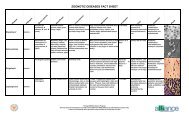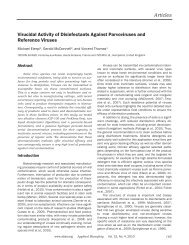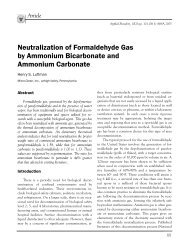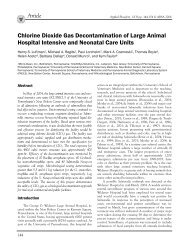Volume 10, Number 4, 2005 - American Biological Safety Association
Volume 10, Number 4, 2005 - American Biological Safety Association
Volume 10, Number 4, 2005 - American Biological Safety Association
You also want an ePaper? Increase the reach of your titles
YUMPU automatically turns print PDFs into web optimized ePapers that Google loves.
ately cleared employees of the contractor. For destruction<br />
of TOP SECRET material, two persons are<br />
required. For destruction of SECRET and CONFI-<br />
DENTIAL material, one person is required.<br />
Destruction records that indicate the date of<br />
destruction, identify the material destroyed, and are<br />
signed by the individuals designated to destroy and<br />
witness the destruction are required for TOP SE-<br />
CRET material.<br />
Information System Security<br />
Information systems (IS) that are used to capture,<br />
create, store, process, or distribute classified<br />
information must be properly managed to protect<br />
against unauthorized disclosure of classified information<br />
and loss of data integrity, and to ensure the<br />
availability of the data and system.<br />
Protection requires a balanced approach including<br />
IS security features to include. but not limited<br />
to, administrative, operational, physical, computer,<br />
communications, and personnel controls. Protective<br />
measures commensurate with the classification of<br />
the information, the threat, and the operational requirements<br />
associated with the environment of the<br />
IS are required.<br />
The requirements outlined in the NISPOM apply<br />
to all information systems processing classified<br />
information. Additional requirements for high-risk<br />
systems and data are covered in the NISPOM Supplement.<br />
The CSA is the Designated Accrediting/<br />
Approving Authority (DAA) responsible for accrediting<br />
information systems used to process classified<br />
information in industry. A formal certification and<br />
accreditation (C&A) occurs after the protection<br />
measures have been implemented and any required<br />
IS protection documentation has been approved.<br />
Certification validates that the protection measures<br />
described in the System Security Plan (SSP) have<br />
been implemented on the system and that the protection<br />
measures are functioning properly. Accreditation<br />
is the approval by the CSA for the system to<br />
process classified information.<br />
A. Hammond<br />
Canada—Industrial Security Manual<br />
Security Classifications<br />
The originator of the information and assets<br />
determines the classification level.<br />
Top Secret<br />
TOP SECRET refers to information and assets<br />
related to the national interest that may qualify for<br />
an exemption or exclusion under the Access to Information<br />
Act or Privacy Act and that the compromise<br />
of which would reasonably be expected to cause<br />
exceptionally grave injury to the national interest.<br />
Secret<br />
SECRET refers to information and assets related<br />
to the national interest that may qualify for an exemption<br />
or exclusion under the Access to Information<br />
Act or Privacy Act and that the compromise of<br />
which would reasonably be expected to cause serious<br />
injury to the national interest.<br />
Confidential<br />
CONFIDENTIAL refers to information and<br />
assets related to the national interest that may qualify<br />
for an exemption or exclusion under the Access<br />
to Information Act or Privacy Act and that the compromise<br />
of which would reasonably be expected to<br />
cause injury to the national interest.<br />
Protected “C”<br />
PROTECTED “C” refers to information and<br />
assets related to other than the national interest that<br />
may qualify for an exemption or exclusion under the<br />
Access to Information Act or Privacy Act that could<br />
reasonably be presumed to cause extremely serious injury,<br />
such as loss of life, if compromised.<br />
Protected “B”<br />
PROTECTED “B” refers to information and<br />
assets related to other than the national interest that<br />
may qualify for an exemption or exclusion under the<br />
Access to Information Act or Privacy Act that could<br />
reasonably be expected to cause serious injury if compromised.<br />
221







